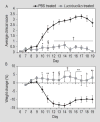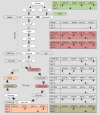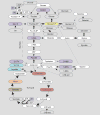Variations in diet cause alterations in microbiota and metabolites that follow changes in disease severity in a multiple sclerosis model
- PMID: 29380645
- PMCID: PMC5918152
- DOI: 10.3920/BM2017.0116
Variations in diet cause alterations in microbiota and metabolites that follow changes in disease severity in a multiple sclerosis model
Abstract
Multiple sclerosis (MS) is a metabolically demanding disease involving immune-mediated destruction of myelin in the central nervous system. We previously demonstrated a significant alteration in disease course in the experimental autoimmune encephalomyelitis (EAE) preclinical model of MS due to diet. Based on the established crosstalk between metabolism and gut microbiota, we took an unbiased sampling of microbiota, in the stool, and metabolites, in the serum and stool, from mice (Mus musculus) on the two different diets, the Teklad global soy protein-free extruded rodent diet (irradiated diet) and the Teklad sterilisable rodent diet (autoclaved diet). Within the microbiota, the genus Lactobacillus was found to be inversely correlated with EAE severity. Therapeutic treatment with Lactobacillus paracasei resulted in a significant reduction in the incidence of disease, clinical scores and the amount of weight loss in EAE mice. Within the metabolites, we identified shifts in glycolysis and the tricarboxylic acid cycle that may explain the differences in disease severity between the different diets in EAE. This work begins to elucidate the relationship between diet, microbiota and metabolism in the EAE preclinical model of MS and identifies targets for further study with the goal to more specifically probe the complex metabolic interaction at play in EAE that may have translational relevance to MS patients.
Keywords: experimental autoimmune encephalomyelitis; metabolomics; microbiome; myelin oligodendrocyte glycoprotein.
Conflict of interest statement
There are no conflicts of interest to report by any of the authors.
Figures






Similar articles
-
Obesity induced gut dysbiosis contributes to disease severity in an animal model of multiple sclerosis.Front Immunol. 2022 Sep 9;13:966417. doi: 10.3389/fimmu.2022.966417. eCollection 2022. Front Immunol. 2022. PMID: 36164343 Free PMC article.
-
Naringenin confers protection against experimental autoimmune encephalomyelitis through modulating the gut-brain axis: A multiomics analysis.J Nutr Biochem. 2023 Dec;122:109448. doi: 10.1016/j.jnutbio.2023.109448. Epub 2023 Sep 22. J Nutr Biochem. 2023. PMID: 37741298
-
Feeding the gut microbiome: impact on multiple sclerosis.Front Immunol. 2023 May 25;14:1176016. doi: 10.3389/fimmu.2023.1176016. eCollection 2023. Front Immunol. 2023. PMID: 37304278 Free PMC article. Review.
-
The Gut-Brain Axis in Multiple Sclerosis. Is Its Dysfunction a Pathological Trigger or a Consequence of the Disease?Front Immunol. 2021 Sep 21;12:718220. doi: 10.3389/fimmu.2021.718220. eCollection 2021. Front Immunol. 2021. PMID: 34621267 Free PMC article. Review.
-
Effect of a Fructose-Rich Diet on Gut Microbiota and Immunomodulation: Potential Factors for Multiple Sclerosis.Immunohorizons. 2023 Mar 1;7(3):213-227. doi: 10.4049/immunohorizons.2300008. Immunohorizons. 2023. PMID: 36939622 Free PMC article.
Cited by
-
Mapping the Literature on Diet and Multiple Sclerosis: A Data-Driven Approach.Nutrients. 2022 Nov 14;14(22):4820. doi: 10.3390/nu14224820. Nutrients. 2022. PMID: 36432507 Free PMC article. Review.
-
What Are the Key Gut Microbiota Involved in Neurological Diseases? A Systematic Review.Int J Mol Sci. 2022 Nov 8;23(22):13665. doi: 10.3390/ijms232213665. Int J Mol Sci. 2022. PMID: 36430144 Free PMC article. Review.
-
The interplay between the gut-brain axis and the microbiome: A perspective on psychiatric and neurodegenerative disorders.Front Neurosci. 2022 Oct 28;16:1030694. doi: 10.3389/fnins.2022.1030694. eCollection 2022. Front Neurosci. 2022. PMID: 36389228 Free PMC article. Review.
-
The Role of Gut Microbiota in Neuropsychiatric Diseases - Creation of An Atlas-Based on Quantified Evidence.Front Cell Infect Microbiol. 2022 Mar 14;12:831666. doi: 10.3389/fcimb.2022.831666. eCollection 2022. Front Cell Infect Microbiol. 2022. PMID: 35360098 Free PMC article. Review.
-
A Comprehensive Review on the Role of the Gut Microbiome in Human Neurological Disorders.Clin Microbiol Rev. 2022 Jan 19;35(1):e0033820. doi: 10.1128/CMR.00338-20. Epub 2022 Jan 5. Clin Microbiol Rev. 2022. PMID: 34985325 Free PMC article. Review.
References
-
- Berer K, Mues M, Koutrolos M, Rasbi ZA, Boziki M, Johner C, Wekerle H, Krishnamoorthy G. Commensal microbiota and myelin autoantigen cooperate to trigger autoimmune demyelination. Nature. 2011;479:538–541. - PubMed
-
- Caporaso JG, Kuczynski J, Stombaugh J, Bittinger K, Bushman FD, Costello EK, Fierer N, Pena AG, Goodrich JK, Gordon JI, Huttley GA, Kelley ST, Knights D, Koenig JE, Ley RE, Lozupone CA, McDonald D, Muegge BD, Pirrung M, Reeder J, Sevinsky JR, Turnbaugh PJ, Walters WA, Widmann J, Yatsunenko T, Zaneveld J, Knight R. QIIME allows analysis of high-throughput community sequencing data. Nature Methods. 2010;7:335–336. - PMC - PubMed
-
- Chen J, Chia N, Kalari KR, Yao JZ, Novotna M, Soldan MM, Luckey DH, Marietta EV, Jeraldo PR, Chen X, Weinshenker BG, Rodriguez M, Kantarci OH, Nelson H, Murray JA, Mangalam AK. Multiple sclerosis patients have a distinct gut microbiota compared to healthy controls. Scientific Reports. 2016;6:28484. - PMC - PubMed
MeSH terms
Grants and funding
LinkOut - more resources
Full Text Sources
Other Literature Sources
Medical

